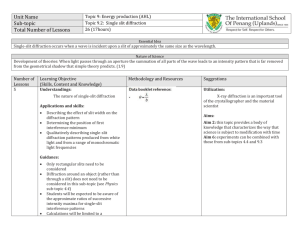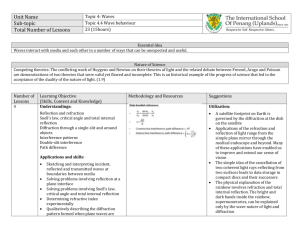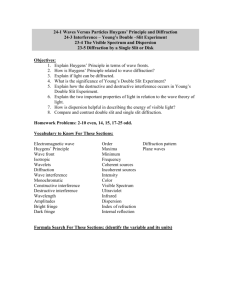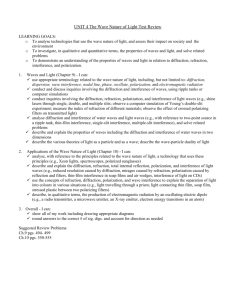Unit 4 - Day 9: Single-Slit Diffraction
advertisement
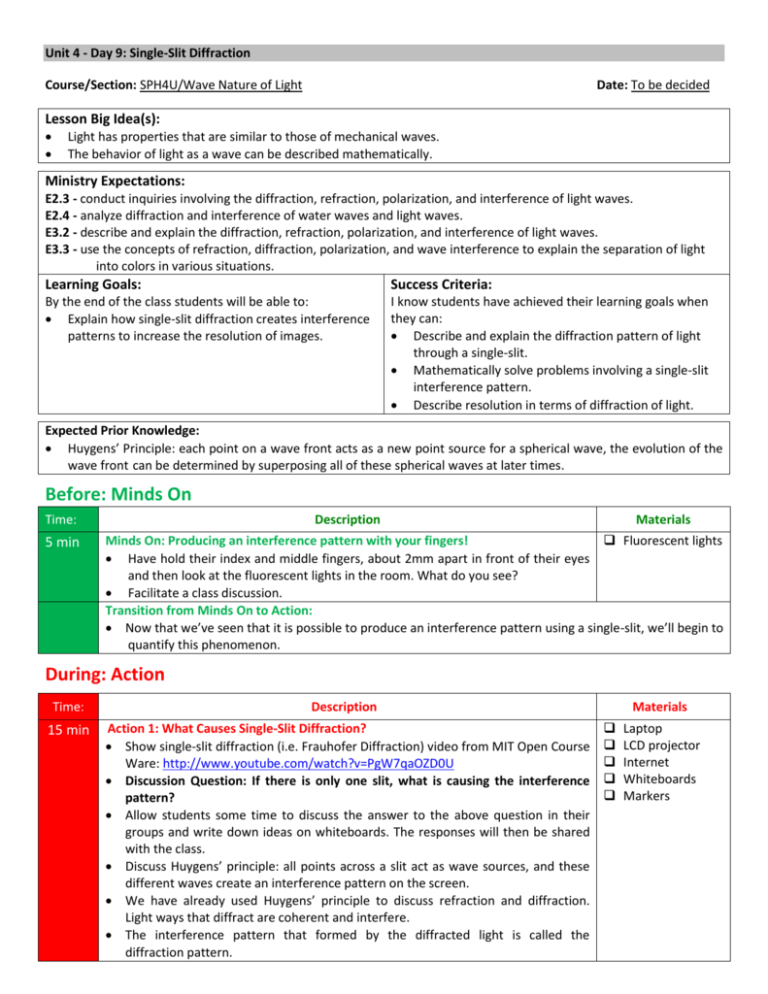
Unit 4 - Day 9: Single-Slit Diffraction Course/Section: SPH4U/Wave Nature of Light Date: To be decided Lesson Big Idea(s): Light has properties that are similar to those of mechanical waves. The behavior of light as a wave can be described mathematically. Ministry Expectations: E2.3 - conduct inquiries involving the diffraction, refraction, polarization, and interference of light waves. E2.4 - analyze diffraction and interference of water waves and light waves. E3.2 - describe and explain the diffraction, refraction, polarization, and interference of light waves. E3.3 - use the concepts of refraction, diffraction, polarization, and wave interference to explain the separation of light into colors in various situations. Learning Goals: Success Criteria: By the end of the class students will be able to: Explain how single-slit diffraction creates interference patterns to increase the resolution of images. I know students have achieved their learning goals when they can: Describe and explain the diffraction pattern of light through a single-slit. Mathematically solve problems involving a single-slit interference pattern. Describe resolution in terms of diffraction of light. Expected Prior Knowledge: Huygens’ Principle: each point on a wave front acts as a new point source for a spherical wave, the evolution of the wave front can be determined by superposing all of these spherical waves at later times. Before: Minds On Time: 5 min Description Materials Minds On: Producing an interference pattern with your fingers! Fluorescent lights Have hold their index and middle fingers, about 2mm apart in front of their eyes and then look at the fluorescent lights in the room. What do you see? Facilitate a class discussion. Transition from Minds On to Action: Now that we’ve seen that it is possible to produce an interference pattern using a single-slit, we’ll begin to quantify this phenomenon. During: Action Time: Description 15 min Action 1: What Causes Single-Slit Diffraction? Show single-slit diffraction (i.e. Frauhofer Diffraction) video from MIT Open Course Ware: http://www.youtube.com/watch?v=PgW7qaOZD0U Discussion Question: If there is only one slit, what is causing the interference pattern? Allow students some time to discuss the answer to the above question in their groups and write down ideas on whiteboards. The responses will then be shared with the class. Discuss Huygens’ principle: all points across a slit act as wave sources, and these different waves create an interference pattern on the screen. We have already used Huygens’ principle to discuss refraction and diffraction. Light ways that diffract are coherent and interfere. The interference pattern that formed by the diffracted light is called the diffraction pattern. Materials Laptop LCD projector Internet Whiteboards Markers Unit 4 - Day 9: Single-Slit Diffraction 40 min Action 2: Mini Investigation - Diffraction of Light Using a Single-Slit See materials in lab handout See separated handout titled Single-Slit Diffraction Lab.docx Copies of Single Students will have seen how the lab is performed in the video from Action 1. Slit Diffraction Have students record their results on the blackboard after they’ve completed their Lab portion of the activity. After: Consolidation Time 15 min Description Materials Consolidation: Summary Blackboard Discuss proportionality relationships from student’s results, i.e. the distance Chalk between adjacent maxima is proportional to the wavelength of light and inversely proportional to the slit spacing. Use their results to develop a formula for the slit spacing, which is consistent with the observed proportionality relationships discovered in class, specifically: Dy = lD w
